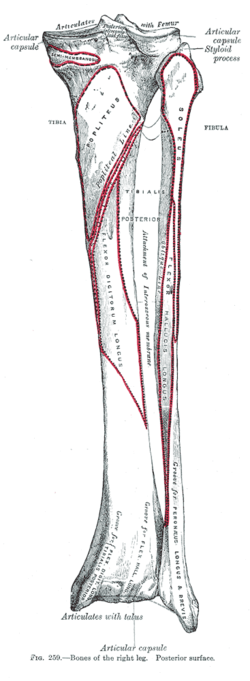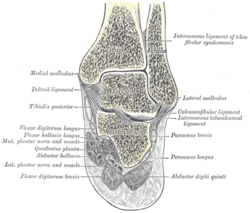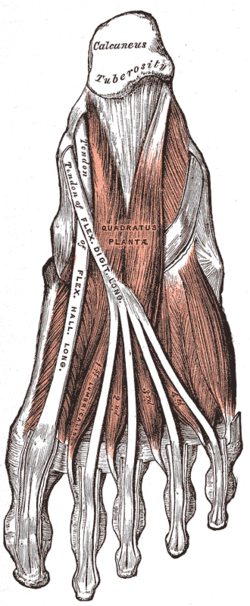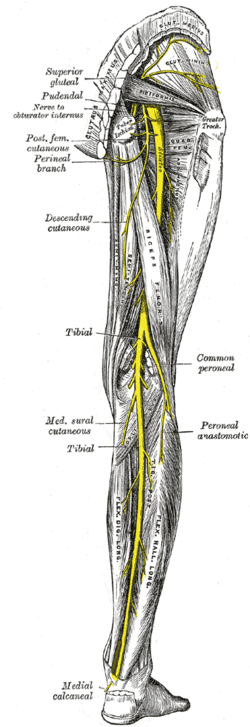Flexor hallucis longus muscle
| Flexor hallucis longus muscle | |
|---|---|
|
The mucous sheaths of the tendons around the ankle. Medial aspect. (Flexor hallucis longus visible at bottom center.) | |
| Details | |
| Origin | fibula, posterior aspect of middle 1/3 |
| Insertion | Plantar surface; base of distal phalanx of hallux |
| Artery | Peroneal artery (peroneal branch of the posterior tibial artery) |
| Nerve | tibial nerve, S1 & S2 more than L5 nerve roots [1] |
| Actions | flexes all joints of the big toe, plantar flexion of the ankle joint |
| Antagonist | Extensor hallucis longus muscle |
| Identifiers | |
| Latin | Musculus flexor hallucis longus |
| TA | A04.7.02.053 |
| FMA | 22593 |
The Flexor hallucis longus muscle (FHL) is one of the three deep muscles of the posterior compartment of the leg that distally attaches to the plantar surface of the distal phalanx of the hallux (great or big toe). The other deep muscles are the flexor digitorum longus and tibialis posterior; the tibialis posterior is the most powerful of these deep muscles. All three muscles are innervated by the tibial nerve which comprises half of the sciatic nerve.[2]
Structure
The Flexor hallucis longus is situated on the fibular side of the leg. It arises from the inferior two-thirds of the posterior surface of the body of the fibula, with the exception of 2.5 cm. at its lowest part; from the lower part of the interosseous membrane; from an intermuscular septum between it and the Peronæi, laterally, and from the fascia covering the Tibialis posterior, medially.
The fibers pass obliquely downward and backward, where it passes through the tarsal tunnel on the medial side of the foot and end in a tendon which occupies nearly the whole length of the posterior surface of the muscle.
This tendon lies in a groove which crosses the posterior surface of the lower end of the tibia, between the medial and lateral tubercoles of the posterior surface of the talus, and the under surface of the sustentaculum tali of the calcaneus; in the sole of the foot it runs forward between the two heads of the Flexor hallucis brevis, and is inserted into the base of the last phalanx of the great toe. The grooves on the talus and calcaneus, which contain the tendon of the muscle, are converted by tendinous fibers into distinct canals, lined by a mucous sheath.
As the tendon passes forward in the sole of the foot, it is situated above, and crosses from the lateral to the medial side of the tendon of the Flexor digitorum longus, to which it is connected by a fibrous slip.
Variation
Usually a slip runs to the Flexor digitorum and frequently an additional slip runs from the Flexor digitorum to the Flexor hallucis. Peroneocalcaneus internus, rare, arises below or outside the Flexor hallucis from the back of the fibula, passes over the sustentaculum tali with the Flexor hallucis and inserts into the calcaneum.
Function
Similar to the flexor digitorum longus and tibialis posterior muscles, the flexor hallucis longus muscle functions to plantar flex and invert the foot. However, it is unique in that it also functions to flex the great toe and helps supinate the ankle.[3]
Injury
After passing through the tarsal tunnel, the flexor hallucis longus tendon must curve around a bony landmark called the sustenaculum tali.[4] Friction at this site is likely to cause plantar-surface foot pain; this condition is called "Stenosing tenosynovitis".[5] This occurs most often in ballet dancers when they go en pointe; plantar flexion of the foot is coupled with the entire weight of the body being supported on the tips of the flexed toes. The heavy load on the FHL tendon increases the individuals risk of friction/irritation at the sustentaculum tali. Hallux saltans is a condition that develops as a result of overusing the FHL muscle. With this condition, a nodule develops along the FHL tendon which may produce a popping effect during contraction because it drags along surrounding tissues.[6]
Additional images
 Bones of the right leg. Posterior surface.
Bones of the right leg. Posterior surface. Left calcaneus, inferior surface.
Left calcaneus, inferior surface. Bones of the right foot. Plantar surface.
Bones of the right foot. Plantar surface. Coronal section through right talocrural and talocalcaneal joints.
Coronal section through right talocrural and talocalcaneal joints. Muscles of the back of the leg. Deep layer.
Muscles of the back of the leg. Deep layer. Muscles of the sole of the foot. Second layer.
Muscles of the sole of the foot. Second layer. The popliteal, posterior tibial, and peroneal arteries.
The popliteal, posterior tibial, and peroneal arteries. Circumpatellar anastomosis.
Circumpatellar anastomosis. Nerves of the right lower extremity Posterior view.
Nerves of the right lower extremity Posterior view. The plantar nerves.
The plantar nerves.- Muscles of the sole of the foot.
- Muscles of the back of the leg. Deep layer.
- Muscles of the back of the leg. Deep layer.
- Muscles of the leg.Posterior view
- Muscles of the sole of the foot.
- Muscles of the sole of the foot.
- Dorsum and sole of Foot. Ankle joint. Deep dissection.
- Ankle joint. Deep dissection. Medial view
References
This article incorporates text in the public domain from the 20th edition of Gray's Anatomy (1918)
- ↑ Aids to the Examination of the Peripheral Nervous System, 5th edition
- ↑ http://www.hopkinsmedicine.org/neurology_neurosurgery/centers_clinics/peripheral_nerve_surgery/conditions/peripheral_nerve_system.html
- ↑ http://www.rad.washington.edu/academics/academic-sections/msk/muscle-atlas/lower-body/flexor-hallucis-longus
- ↑ http://www.massagetoday.com/mpacms/mt/article.php?id=14152
- ↑ http://www.massagetoday.com/mpacms/mt/article.php?id=14152
- ↑ http://www.massagetoday.com/mpacms/mt/article.php?id=14152
External links
| Wikimedia Commons has media related to Flexor hallucis longus muscle. |
- -281739185 at GPnotebook
- Anatomy photo:15:st-0404 at the SUNY Downstate Medical Center
- PTCentral
